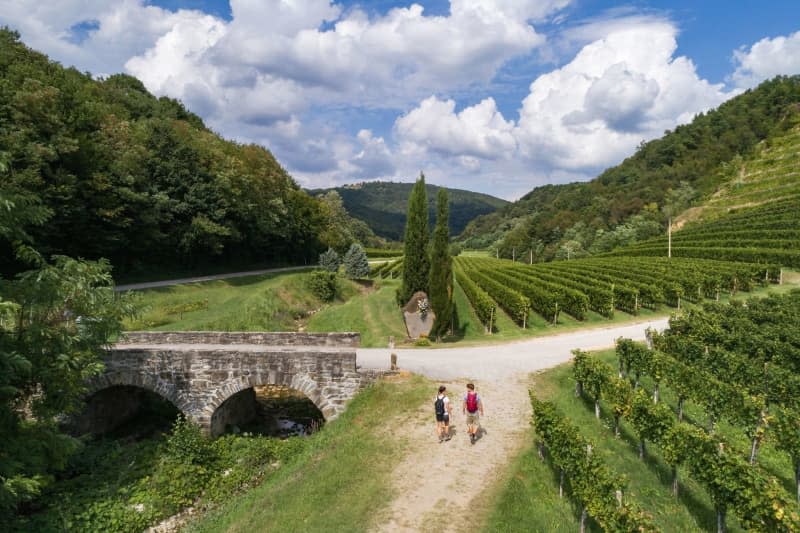Mauro Leban’s family farm in Gorizia, Italy sits at the heart of a region shaped by history.
The towns of Nova Gorica and Gorizia on both sides of the Italian-Slovenian border will serve as European Capitals of Culture for 2025.
The neighbouring towns’ program will focus on the theme of overcoming borders, with the motto: “GO! Borderless.”
But it hasn’t always been this way.
In 1947, a cow stood with its front legs in what was then Yugoslavia and its hind legs in Italy, straddling a chalk line that marked a new border.
The scene is captured in a photograph dated September 17, 1947.
For the Lebans, this line wasn’t just a border – it was a harbinger of upheaval that would redefine their lives.
That line symbolized the implementation of the Paris Peace Conference, which divided the town of Gorizia and transformed lives overnight.
The decision was adopted by the World War II victors in February of that year.
Leban recalls how his father and uncles, aware that changes were imminent, were still shocked by the swiftness of the transformation.
Their farm found itself bisected by the new border, with the farmhouse in Italy and the fields in Yugoslavia.
Faced with a painful decision, the family opted to remain in Italy. Fortunately, according to Leban, the authorities agreed to adjust the course of the border fence so that the cowshed remained on Italian territory.
For the next eight years, the Lebans were among the few permitted to cross the border to tend their fields, a temporary privilege amidst strict controls.
This episode is emblematic of Gorizia’s turbulent history.
Once part of the Austro-Hungarian Empire, the town transitioned to Italy after World War I. Even then, Gorizia was cosmopolitan, because while German was spoken in the offices, coffee was ordered in Italian.
The town faced new upheavals when Yugoslavia’s leader Josip Broz Tito sought to annex it post World War II. When he failed, Tito decided to build a new city just across the border – Nova Gorica.
Tito’s original vision was only partially realized.
The town, now home to 13,000 residents, exudes vitality, bolstered in part by the university established in 1995.
Nearby, visitors can explore attractions like the historic Franciscan Monastery of Kostanjevica or the remarkable Solkan Bridge.
This architectural marvel spans the emerald waters of the Isonzo River (known as the Soča in Slovenia) and boasts the world’s largest stone arch.
Once part of the first transalpine railway route in 1906, the bridge symbolically connected Gorizia with the Austro-Hungarian Empire, cementing its historical significance.
Meanwhile, Gorizia, which has a population of 35,000, showcases its Italian charm, with historic sites like the Borgo Castello castle and culinary delights from Friuli-Venezia Giulia.
In 2025, the two cities will jointly serve as European Capitals of Culture under the motto “GO! Borderless”
But back on Mauro Leban’s farm, a tollgate painted in the Italian tricolour serves as a poignant reminder of the division that once defined the region.
Nearby, a small documentation centre offers video recordings of contemporary witnesses recounting the painful years when families were separated – some living in the much smaller eastern part of old Gorizia or in Nova Gorica.
These testimonies also reveal the deep mistrust that grew between perceived fascists and communists during the era of separation.
The border, hermetically sealed after its establishment, remained in place until 1955, when an agreement allowed relatives limited visitation rights.
Yet, even after the fall of the Iron Curtain and Slovenia’s independence, the physical divide persisted for another 16 years.
It was finally dismantled in 2007, when Slovenia joined the Schengen Area, which allows travel without border controls across many European countries, erasing the last physical traces of division in what had been Europe’s final divided city.
When Nova Gorica was officially named the European Capital of Culture for 2025 a few years ago, it marked a historic milestone as the first cross-border cultural capital.
At the time, few could have predicted that political conditions would shift dramatically before the celebrations could even begin.
Italy’s government under far-right Prime Minister Giorgia Meloni reintroduced border checks between Italy and Slovenia in October, a reminder that the vision of unity faces ongoing challenges.
Kromberk Castle, which was restored after World War II, is located near Nova Gorica. Jošt Gantar/www.slovenia.info/dpa

The Solkan Bridge spans the Isonzo River (known as the Soča in Slovenia) and boasts the world’s largest stone arch. Ernad Ihtijarević/www.slovenia.info/dpa

The Collio – or Goriška Brda – wine-growing region is popular with hikers. Jošt Gantar/www.slovenia.info/dpa

Gorizia’s Borgo Castello castle dates back to the 11th century. Fabrice Gallina/Promoturismo FVG/dpa
Read the full article here
